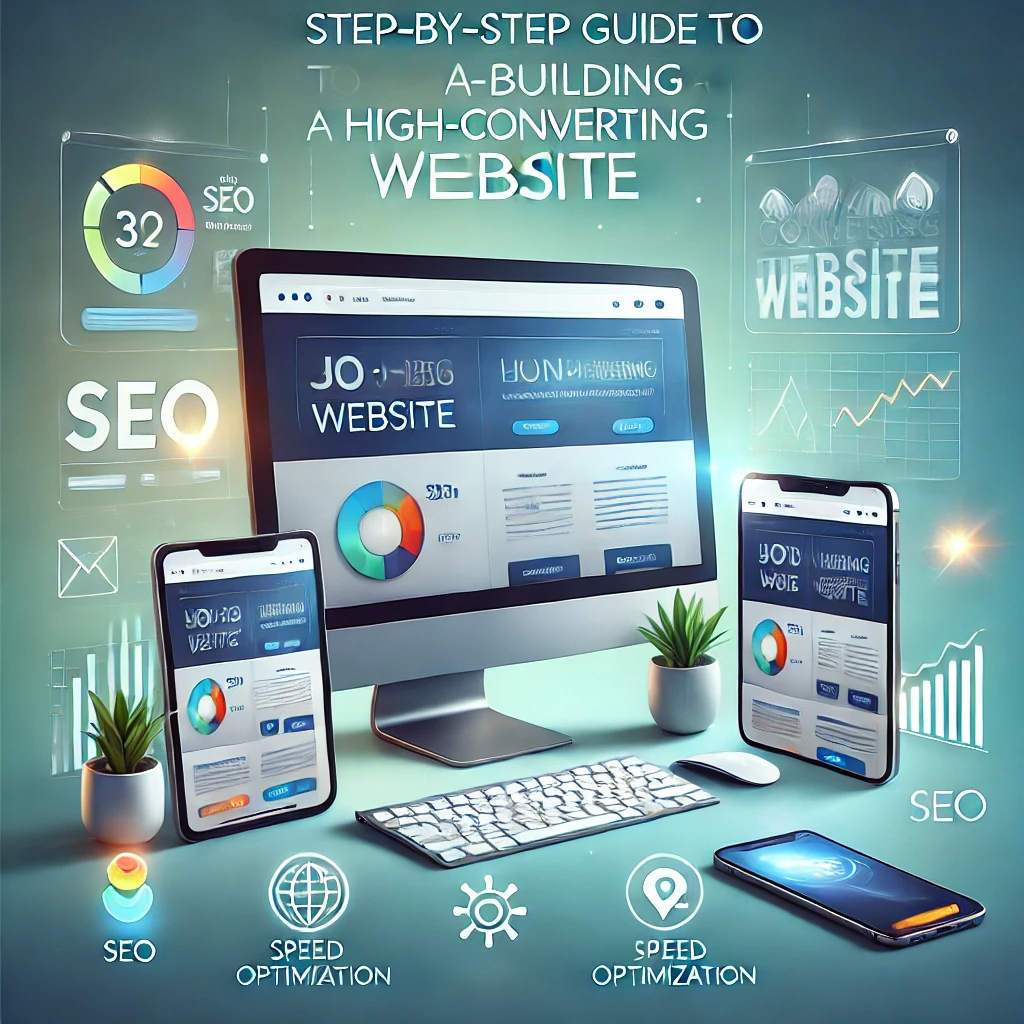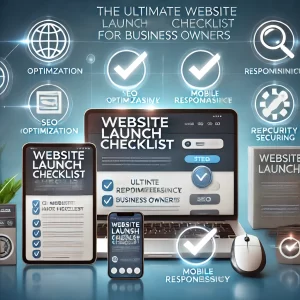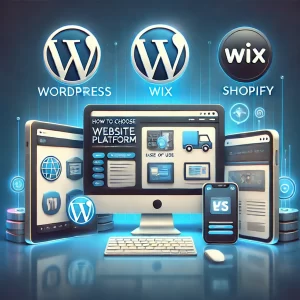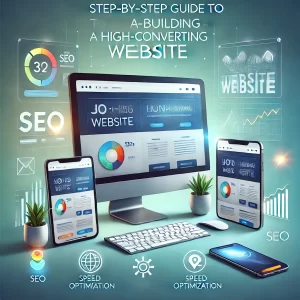
The Step-by-Step Guide to Building a High-Converting Website
Your website is more than just an online presence—it’s your most powerful tool for attracting, engaging, and converting visitors into loyal customers. A high-converting website doesn’t just look great; it’s strategically designed to guide users toward taking action, whether that’s making a purchase, filling out a form, or signing up for a newsletter.
If you’re ready to build a website that works for your business 24/7, here’s your ultimate step-by-step guide to creating a high-converting website.
Step 1: Define Your Goals
Before you start building your website, it’s essential to know what you want to achieve. Are you looking to:
- Sell products or services?
- Generate leads?
- Build brand awareness?
- Provide information or resources?
Pro Tip: Write down your primary and secondary goals, and ensure every page of your website supports at least one of these objectives. For example:
- Primary Goal: Generate leads through a contact form.
- Secondary Goal: Educate users with blog content.
Step 2: Research Your Target Audience
Understanding your audience is crucial for creating a website that resonates with them. Dive into the demographics, behaviors, and preferences of your ideal customers.
Key Questions to Ask:
- Who is your ideal customer?
- What problems are they trying to solve?
- What motivates them to take action?
Pro Tip: Use tools like Google Analytics, customer surveys, and social media insights to gather data about your audience. Tailor your website’s tone, visuals, and content to match their preferences.
Step 3: Plan Your Website’s Structure (Sitemap)
A well-organized website structure makes it easy for visitors to find what they need, reducing frustration and boosting conversions. Start with a sitemap, which is a blueprint for your website’s pages.
Basic Sitemap for Most Businesses:
- Home Page: The main entry point.
- About Us: Share your story and mission.
- Products/Services: Highlight your offerings.
- Contact Page: Make it easy for users to reach you.
- Blog: Publish educational content (optional but highly recommended).
Pro Tip: Keep your navigation simple and limit your main menu to 5–7 items. Use dropdown menus sparingly to avoid overwhelming visitors.
Step 4: Choose the Right Website Platform
Selecting the right platform is critical for functionality and scalability.
Popular Options:
- WordPress: Highly customizable, suitable for all types of websites.
- Wix/Squarespace: Beginner-friendly, ideal for small businesses or personal sites.
- Shopify: Perfect for e-commerce stores.
- Custom Development: Best for complex or unique requirements.
Pro Tip: For maximum flexibility and SEO benefits, WordPress is a top choice. Pair it with a responsive theme for a professional look.
Step 5: Focus on Visual Design
Your website’s design is the first thing visitors notice. An attractive, user-friendly design can make the difference between a visitor staying or bouncing.
Key Design Principles:
- Responsive Design: Ensure your site works seamlessly on all devices.
- White Space: Use spacing effectively to avoid clutter.
- Consistent Branding: Match your website’s colors, fonts, and imagery to your brand identity.
- Visual Hierarchy: Highlight key elements like headlines and CTAs using size, color, or placement.
Pro Tip: Invest in professional photography or high-quality stock images to create a polished look.
Step 6: Write Compelling Copy
Your website copy should do more than describe your products or services—it should persuade visitors to take action.
Tips for Writing High-Converting Copy:
- Speak to Pain Points: Show how your business solves their problems.
- Use Clear CTAs: Guide users with phrases like “Buy Now,” “Get Started,” or “Contact Us.”
- Keep It Simple: Avoid jargon and focus on benefits, not just features.
Example: Instead of saying, “We offer top-notch customer support,” say, “Get answers to your questions 24/7 with our friendly support team.”
Step 7: Optimize for Speed and Performance
A slow-loading website is a conversion killer. Visitors expect your site to load in 2 seconds or less.
How to Improve Speed:
- Use a reliable hosting provider.
- Compress images without losing quality.
- Minimize CSS, JavaScript, and HTML files.
- Enable browser caching and use a Content Delivery Network (CDN).
Pro Tip: Tools like Google PageSpeed Insights and GTmetrix can help identify areas for improvement.
Step 8: Implement SEO Best Practices
Search Engine Optimization (SEO) is key to driving organic traffic to your site.
Basic SEO Checklist:
- Keywords: Research relevant terms and incorporate them into your copy.
- Meta Tags: Optimize titles and descriptions for search engines.
- Alt Text: Add descriptive text to all images.
- Internal Linking: Link to other pages on your site to improve navigation.
Pro Tip: Publish valuable, keyword-rich blog content to attract more visitors and boost your authority.
Step 9: Add Lead Capture Forms
If one of your goals is lead generation, make it easy for users to provide their contact information.
Examples of Lead Capture Strategies:
- Newsletter Sign-Up Forms: Offer a free resource like an ebook or discount in exchange for their email.
- Contact Forms: Keep them simple—ask for only the information you need.
- Exit-Intent Pop-Ups: Trigger these when users are about to leave your site.
Pro Tip: Use tools like HubSpot or Mailchimp to manage and nurture your leads.
Step 10: Test, Launch, and Optimize
Before launching your website, conduct thorough testing to ensure everything works as intended.
Pre-Launch Checklist:
- Test your site on multiple devices and browsers.
- Check all links, forms, and buttons.
- Proofread for typos and errors.
- Ensure SSL (Secure Sockets Layer) is installed for site security.
After launching, monitor your website’s performance and make improvements based on user behavior and feedback.
Pro Tip: Use analytics tools like Google Analytics and Hotjar to track metrics like bounce rates, time on site, and conversion rates.
How The Tech Plug Can Help
At The Tech Plug, we specialize in building high-converting websites tailored to your unique business needs. Whether you’re starting from scratch or revamping an existing site, our team has the expertise to deliver results.
Why Choose Us?
- Custom designs optimized for conversions.
- Mobile-first, responsive websites.
- Integrated SEO strategies to drive organic traffic.
Ready to build a website that works for your business? Let’s bring your vision to life! Contact us today to get started.
FAQs
1. How much does it cost to build a high-converting website?
The cost depends on your goals, features, and complexity. At The Tech Plug, we offer scalable solutions to fit your budget.
2. How long does it take to build a website?
On average, a standard website takes 4–8 weeks, depending on the project scope.
3. What is the most important feature of a high-converting website?
User experience (UX) is the cornerstone of conversions. A site that is easy to navigate and fast to load will keep visitors engaged.
4. Can I improve conversions on my current website?
Absolutely! Simple changes like improving CTAs, optimizing speed, and refining copy can boost your conversion rate.
5. What platforms do you recommend for building a website?
We recommend WordPress for flexibility and Shopify for e-commerce. However, we tailor our recommendations to your specific needs.





